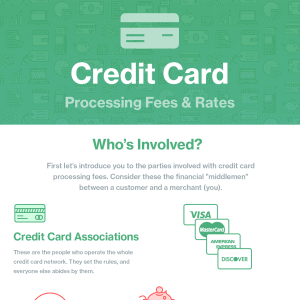How credit and debit payments are processed affects your costs, what minimum charges you can enforce, and whether you can add surcharges.
Our content reflects the editorial opinions of our experts. While our site makes money through
referral partnerships, we only partner with companies that meet our standards for quality, as outlined in our independent
rating and scoring system.
For customers, paying with debit or credit feels the same. For businesses, though, the costs, timing, and rules behind each type of transaction can be very different.
Let’s break down how credit and debit payments work, what they cost, and the key differences that matter for your business. Once you understand the basics, you can start looking for the best credit card processors for your business.
The Basic Difference Between Credit And Debit Transactions
Credit transactions are run through credit card networks (Visa, Mastercard, Amex, Discover), and what merchants pay depends on their payment processor.
Debit transactions run on debit/ATM networks, and merchants are charged a debit-specific rate.
The main difference for merchants is cost. Debit usually has lower fees — especially on larger purchases — while credit often costs more.
How Credit Transactions Work
When a customer pays with a credit card:
- Payment info travels from the merchant to the processor to the acquiring bank.
- The acquiring bank requests approval from the issuing bank.
- The issuer checks the customer’s credit limit and authorizes.
- The acquiring bank pays the merchant.
- The two banks pay each other to settle the charges.
- The consumer repays the issuing bank according to the terms of the card agreement.
Because banks are essentially extending a short-term loan, credit transactions carry more risk for issuers — and usually higher fees for merchants.
How Debit Transactions Work
Debit cards pull money directly from the customer’s bank account. The issuing bank confirms the funds are available, places a temporary hold, and authorizes payment. Risk of default is minimal since the funds already exist.
But debit can be processed in two different ways — and that choice impacts fees, speed, and security.
Credit Path Debit VS True Debit
| Debit Type |
Network |
PIN? |
Settlement Speed |
Cost Trend |
| Credit Path Debit (Debit as Credit) |
Credit card networks |
No |
2–3 days |
Similar to credit rates |
| True Debit (PIN Debit) |
ATM/debit networks |
Yes |
Same day / within hours |
Lower on larger purchases |
The credit path debit (or debit as credit) option goes through the credit card network even though it’s a debit card. No PIN is required for these transactions.
With these transactions, the issuing bank places a hold on the funds, authorizes the payment, and transfers money through the credit network. The merchant receives funds in the same 2–3 day timeframe as a regular credit card transaction.
Credit path debit fees are usually similar to credit card rates, though some processors offer slightly lower rates.
True debit (or PIN debit) uses a separate debit/ATM network, not the credit card network. This option requires a PIN, adding a layer of security.
The issuing bank immediately places a hold and transfers funds directly to the merchant’s bank. Settlement is much faster — sometimes within hours or by the end of the business day. Fees tend to be lower on larger transactions because the network costs less to use.
So to break it down in the simplest of terms:
- Credit path debit is slower and often costs more, but can be easier for customers who choose “credit” at the terminal.
- True debit is faster, more secure (PIN required), and cheaper on larger transactions, but requires a POS terminal with a PIN pad.
Merchant Fees For Credit & Debit
The fees you pay depend on which path is used and the size of the bank backing the card.
| Transaction Type |
Description |
Processing Rate |
| Credit Transactions |
Standard credit card charges, processed through the credit network. |
1.5%–2.9% swiped/dipped/tapped, 3.5% keyed-in |
| Debit Transactions (True Debit / PIN) |
Uses the debit network with a PIN; funds move directly from the customer’s bank account. |
0.05% + $0.21–$0.22 per Durbin cap, 0.44%–1.09% average otherwise |
| Credit Path Debit Transactions |
Debit card processed through the credit network; no PIN required. |
Same as credit card rates or slightly lower depending on processor |
Merchants pay fees for every transaction. Cards processed through a credit network are charged standard credit card rates, while debit cards processed through a debit network use a debit-specific rate. Some processors offer a middle rate for credit path debit transactions — higher than true debit but lower than credit.
For debit cards issued by large U.S. banks (over $10B in assets), the federal standard rate under the Durbin Amendment is 0.05% + $0.21 per transaction (or $0.22 if certain fraud criteria apply). Smaller banks may charge more, and processors may add a markup. Non-U.S. debit cards can be even cheaper. Credit card rates vary by processor, so always check your processing agreement.
In general, smaller purchases cost less as credit path debit transactions, while larger purchases are cheaper as true debit transactions. Understanding these differences helps you choose the most cost-effective way to accept debit and credit cards.
More Key Differences Between Credit & Debit Transactions
The difference between credit and debit transactions extends beyond per-transaction rates. Let’s explore some of the other differences.
|
Credit transactions |
Debit transactions |
Credit path debit transactions |
| Pricing rates |
1.5% to 2.9% for swiped/dipped/tapped transactions, 3.5% for keyed-in transactions |
0.05% + $0.21 or $0.22 per transaction for transactions that fall under the Durbin cap, 0.44% to 1.09% on average for transactions that don’t |
Same as credit card rates with some processors, somewhere between true credit and true debit with others |
| Can apply surcharge? |
Yes (in 46 states) |
No |
Yes (in 46 states) |
| Can apply convenience fee? |
Yes (rules vary by card network) |
No |
Yes (rules vary by card network) |
| When are funds withdrawn from the customer’s bank? |
Up to three days later |
Within hours/by the end of the business day |
Up to three days later |
| PIN entry required? |
Not in the US |
Yes |
Not in the US |
Disputes
Credit and debit card disputes follow different rules. Both first appear as chargebacks on a merchant’s statement, which the merchant can respond to through their processor.
Debit disputes usually appear earlier, and if the consumer misses the reporting window for a stolen debit card, the merchant keeps the funds.
Credit card disputes follow different laws, limit consumer liability to $50, and allow a longer timeframe to challenge charges, so merchants may deal with these disputes later.
Minimum Amounts & Surcharges
Merchants can set a minimum purchase or add a surcharge for credit card transactions, if allowed by state law and card network rules.. These rules generally discourage surcharges and support using credit cards for any transaction size.
Debit cards are different. Merchants cannot set a minimum or charge extra for using a debit card. Federal law forbids it, so debit transactions must be treated equally regardless of amount.
Why Credit VS Debit Matters For Small Businesses
For merchants, the real differences between debit and credit transactions come down to fees, timing, and dispute rules. Debit is often cheaper and faster, but credit gives customers more protection.
Accepting both lets customers pay their way while keeping your costs predictable and avoiding surprises.
To learn more about payment processing costs, read our comprehensive guide to credit card processing fees.












